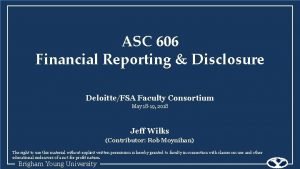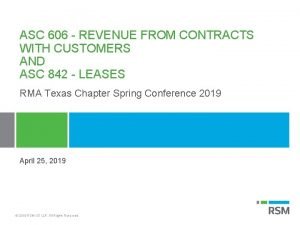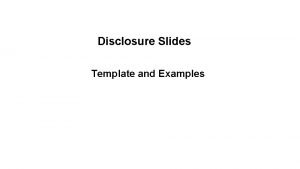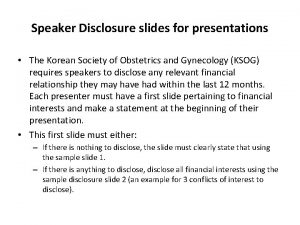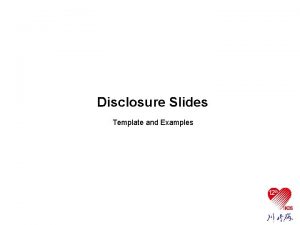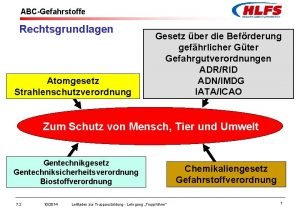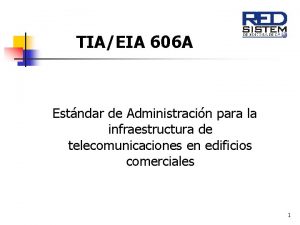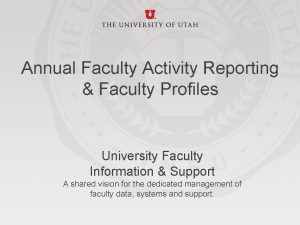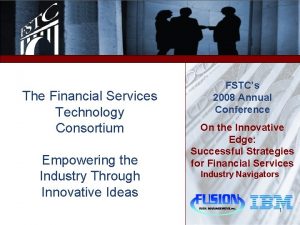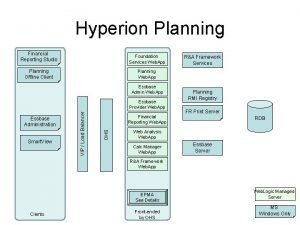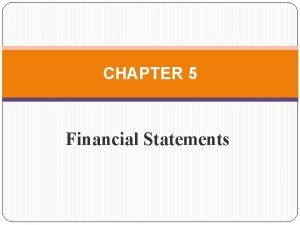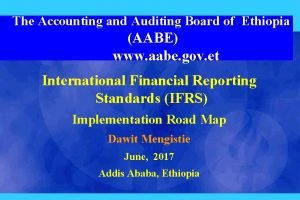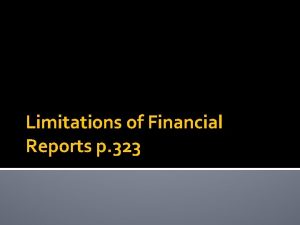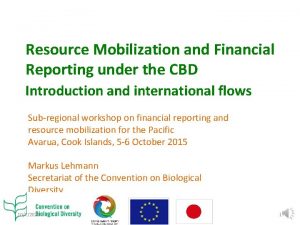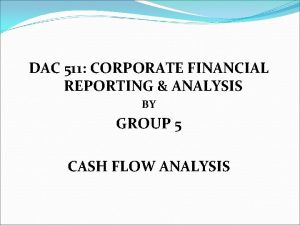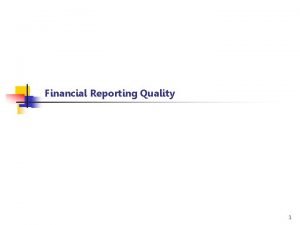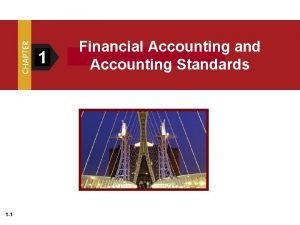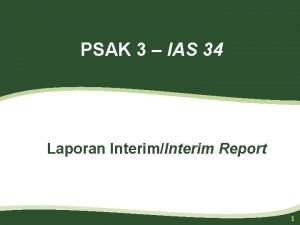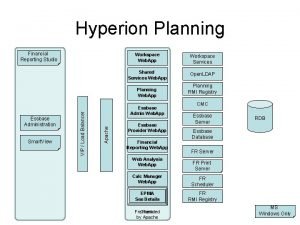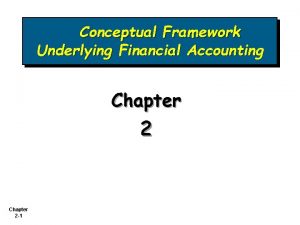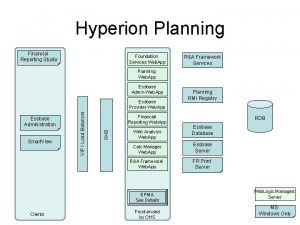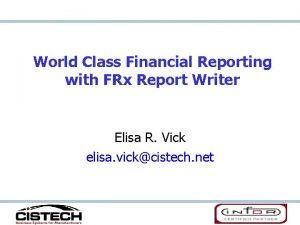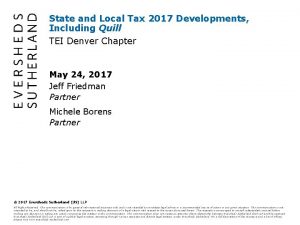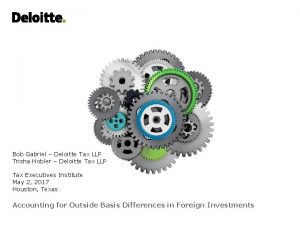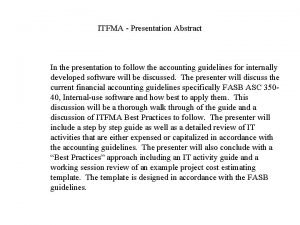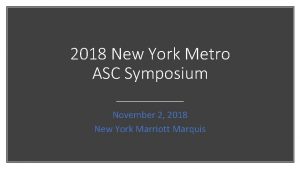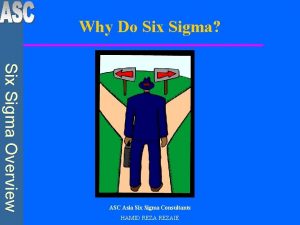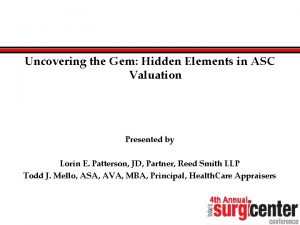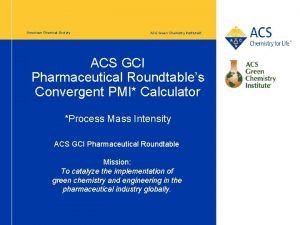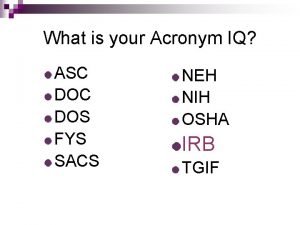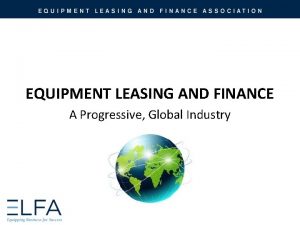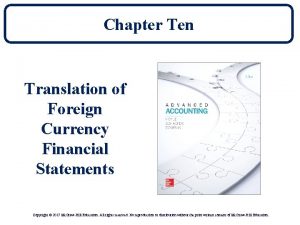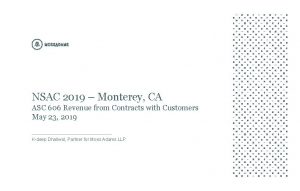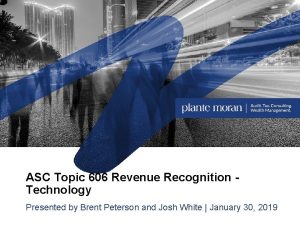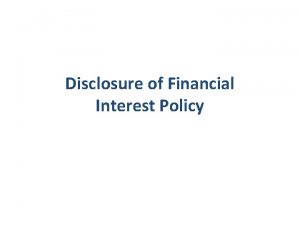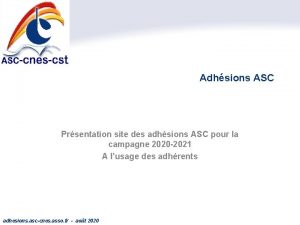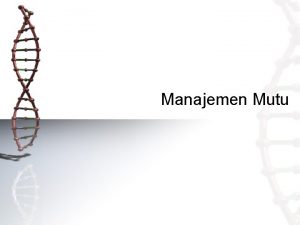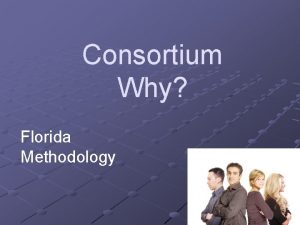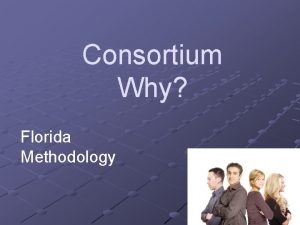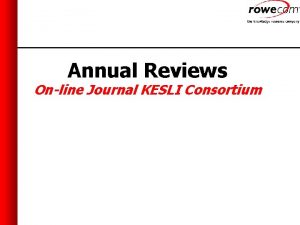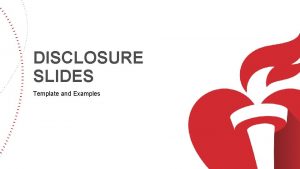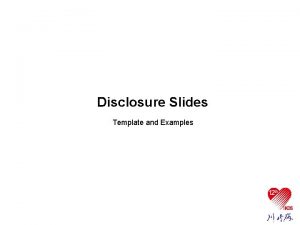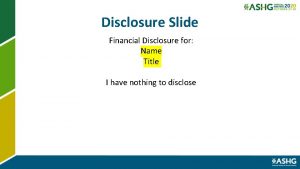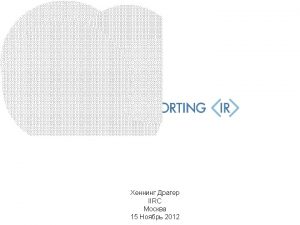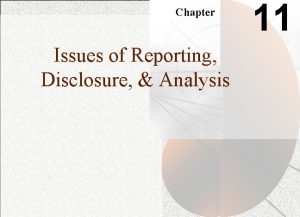ASC 606 Financial Reporting Disclosure DeloitteFSA Faculty Consortium
























































- Slides: 56

ASC 606 Financial Reporting & Disclosure Deloitte/FSA Faculty Consortium May 18 -19, 2018 Jeff Wilks (Contributor: Rob Moynihan) The right to use this material without explicit written permission is hereby granted to faculty in connection with classroom use and other educational endeavors of a not for profit nature. Brigham Young University

Topics • Presentation: Payments to customers • Allocation periods: Upfront fees and contract costs • Disclosure: Examples and SEC questions Brigham Young University

Case 1 CBOE Holdings, Inc. Brigham Young University

Instructions • Read the excerpts from CBOE Holding’s June 30, 2017 10 -Q and the SEC’s question regarding CBOE’s revenue recognition policy. • Determine the appropriate accounting treatment for CBOE’s liquidity payments based on ASC 606. • Be prepared to justify your conclusions. 10 Minutes Brigham Young University

Brigham Young University

Buyers Sellers Transaction fee Liquidity rebate Brigham Young University

Buyers Liquidity rebate Brigham Young University Sellers Transaction fee

Invoice Transaction fees Liquidity rebates $45, 753 Brigham Young University

Codification ASC 606 -10 -32 -25 An entity shall account for consideration payable to a customer as a reduction of the transaction price and, therefore, of revenue unless the payment to the customer is in exchange for a distinct good or service… that the customer transfers to the entity. Brigham Young University

Codification ASC 606 -10 -32 -26 If consideration payable to a customer is a payment for a distinct good or service from the customer, then an entity shall account for the purchase of the good or service in the same way that it accounts for other purchases from suppliers. … If the entity cannot reasonably estimate the fair value of the good or service received from the customer, it shall account for all of the consideration payable to the customer as a reduction of the transaction price. Brigham Young University

CBOE’s Response The second type of rebates paid to customers are liquidity payments, which we consider a distinct transaction and record as a cost of revenue in liquidity payments on the consolidated statements of income. We believe that providing (or removing) liquidity is a distinct service that is provided by customers, as we benefit from having an enhanced liquidity pool available on our markets, and that it is separately identifiable given its separation on the published fee schedules. We believe the enhanced liquidity pool attracts order flow and promotes order execution on our trading platforms. Brigham Young University

CBOE’s Response Through enhanced order flow, and therefore higher market share, we also earn additional market data revenue from the Securities Information Processor (SIP) plans and the Options Price Reporting Authority (OPRA), and our own proprietary market data becomes more valuable as more trades are included. Also as our market share grows, so does the need for our customers to become connected to markets, which results in higher connectivity revenue. Therefore, we account for the purchase of this service from our customers as an expense, just as we would account for the purchase of services acquired from any other vendor, in accordance with ASC 606 -10 -32 -26. Brigham Young University

Brigham Young University

Case 2 Pesky Sales Commissions Brigham Young University

Instructions • Read the Pesky case and determine the appropriate accounting for the upfront activation fee and sales commissions, based on ASC 340 -40 and ASC 606. • Be prepared to justify your conclusions. 10 Minutes Brigham Young University

Revenue Recognition: Upfront fees $60 Y 0 $60 Y 1 Brigham Young University Y 2 Y 3 Y 4

Codification: Upfront Fees ASC 606 -10 -55 -51 In many cases, even though a nonrefundable upfront fee relates to an activity that the entity is required to undertake at or near contract inception to fulfill the contract, that activity does not result in the transfer of a promised good or service to the customer (see paragraph 606 -10 -25 -17). Instead, the upfront fee is an advance payment for future goods or services and, therefore, would be recognized as revenue when those future goods or services are provided. Brigham Young University

Codification: Upfront Fees ASC 606 -10 -55 -51 The revenue recognition period would extend beyond the initial contractual period if the entity grants the customer the option to renew the contract and that option provides the customer with a material right as described in paragraph 606 -10 -55 -42. Brigham Young University

Codification: Upfront Fees ASC 606 -10 -55 -42 … that option gives rise to a performance obligation in the contract only if the option provides a material right to the customer that it would not receive without entering into that contract (for example, a discount that is incremental to the range of discounts typically given for those goods or services to that class of customer in that geographical area or market). Brigham Young University

Y 1 Brigham Young University Y 2 Y 3

Expense Recognition: Commission $100 Y 0 $100 Y 1 Brigham Young University Y 2 Y 3 Y 4

Codification: Commissions ASC 340 -40 -25 -4 As a practical expedient, an entity may recognize the incremental costs of obtaining a contract as an expense when incurred if the amortization period of the asset that the entity otherwise would have recognized is one year or less. Brigham Young University

Codification: Commissions ASC 340 -40 -35 -1 An asset recognized in accordance with paragraph 34040 -25 -1 or 340 -40 -25 -5 shall be amortized on a systematic basis that is consistent with the transfer to the customer of the goods or services to which the asset relates. The asset may relate to goods or services to be transferred under a specific anticipated contract (as described in paragraph 34040 -25 -5(a)). Brigham Young University

Y 1 Brigham Young University Y 2 Y 3

Why is the allocation period for upfront fees determined differently from the allocation period for incremental costs? Upfront fees: original contract term unless material right Commissions: goods and services to which related Brigham Young University

How does the difference between the year-one commission ($100) and the renewal commission ($40) affect your conclusion about the goods and services to which the first commission relates? Brigham Young University

Brigham Young University

If an entity determines that the commission on the renewal contract is not commensurate with the commission on the initial contract (or there is no commission on the renewal contract), the staff thinks the new revenue standard requires that the amortization period extend beyond the initial contract term if there anticipated renewals with goods or services that relate to the costs of obtaining the initial contract (p. 12). Brigham Young University

In the staff’s view, the key question is not whether a commission is commensurate with the level of effort to obtain the contract. The level of effort is about the past and it is not about the period over which the entity will transfer goods or services to which the asset relates (p. 17). Brigham Young University

Where do TRG memos and discussions fit in the GAAP Hierarchy? Are they authoritative? Brigham Young University

I would strongly encourage a registrant, whether domestic or foreign, to consult with the Office of the Chief Accountant if the registrant intends to select and implement an accounting policy for revenue that is inconsistent with TRG discussions. Brigham Young University

Brigham Young University

Brigham Young University

Case 3 Ford Motor Company Brigham Young University

Instructions • Read the Ford Motor Company case and determine the categories you would want to see Ford use when disaggregating its revenue from contracts with customers, based on ASC 606 -10 -50 -5. • Be prepared to justify your conclusions. 10 Minutes Brigham Young University

Disclosure Objective ASC 606 -10 -50 -1 The objective of the disclosure requirements in this Topic is for an entity to disclose sufficient information to enable users of financial statements to understand the nature, amount, timing, and uncertainty of revenue and cash flows arising from contracts with customers. Brigham Young University

Disaggregated Revenue ASC 606 -10 -50 -5 An entity shall disaggregate revenue recognized from contracts with customers into categories that depict how the nature, amount, timing, and uncertainty of revenue and cash flows are affected by economic factors. An entity shall apply the guidance in paragraphs 606 -10 -55 -89 through 5591 when selecting the categories to use to disaggregate revenue. Brigham Young University

Disaggregation Categories ASC 606 -10 -55 -90 When selecting the type of category (or categories) to use to disaggregate revenue, an entity should consider how information about the entity’s revenue has been presented for other purposes, including all of the following: a. Disclosures presented outside the financial statements (for example, in earnings releases, annual reports, or investor presentations) Brigham Young University

Disaggregation Categories ASC 606 -10 -55 -90 b. Information regularly reviewed by the chief operating decision maker for evaluating the financial performance of operating segments c. Other information that is similar to the types of information identified in (a) and (b) and that is used by the entity or users of the entity’s financial statements to evaluate the entity’s financial performance or make resource allocation decisions. Brigham Young University

Disaggregation Categories ASC 606 -10 -55 -91 a. Type of good or service* b. Geographical region* c. Market or type of customer* d. Type of contract e. Contract duration f. Timing of transfer of goods or services* g. Sales channels Brigham Young University

SEC Letter to Ford With respect to the disclosure requirements of ASC 606 -10 -50 -5, please tell us how you considered the guidance in paragraphs ASC 606 -10 -55 -89 through 5591 in selecting the appropriate categories to use to disaggregate revenue (August 17, 2017). Brigham Young University

Ford’s Response The information about our revenue that we disclose to investors and users of our financial statements is the same that is used by our chief operating decision maker for evaluating the financial performance and making resource decisions. In our earnings releases, annual reports, and investor presentations, we present revenue for our reportable segments…and by geographical region. Brigham Young University

Ford’s Response Rather than repeat the geographical disaggregation of revenue in our ASC 606 financial statement disclosures, … we concluded that the disclosure for major sources of revenue that would be most meaningful to the users of our financial statements and best meet the disclosure requirements under ASC 606 would be Brigham Young University

Ford’s Response • Products/services • Customer class • Timing of cash flows • Timing of revenue recognition • Pricing model • Significant ongoing performance obligations Brigham Young University

Brigham Young University

SEC Letter to Ford You present “vehicles, parts, and accessories” as a major source of revenue. Please explain to us why the aggregation of revenue from “parts and accessories” with revenue from “vehicles” is appropriate pursuant to ASC 606 -10 -50 -5. We note from your disclosures that parts and accessories appear to be subject to return from customers, whereas this does not appear to be the case for vehicles. It also appears these categories may have other different characteristics, such as type of good, pricing and dollar magnitude of contribution to margin (Aug. 17, 2017). Brigham Young University

Ford’s Response • Products/services – Parts and accessories are products that essentially provide a form of annuity earned from the sale of vehicles • Customer class – Vehicles, parts, and accessories are sold primarily to the same customer class – the dealers • Timing of cash flows – Cash from the sale of vehicles, parts and accessories is received from the customer’s financing source at the time of sale Brigham Young University

Ford’s Response • Timing of revenue recognition – Revenue is recognized when we transfer control of vehicles, parts, and accessories which is generally at the point of shipment from our manufacturing facilities or depots • Pricing model – The pricing model for vehicles, parts, and accessories results in variable consideration • Significant ongoing performance obligations – Contracts for sales of vehicles, parts, and accessories do not involve significant ongoing performance obligations Brigham Young University

Other Disclosures • Contract balances (contract assets, contract liabilities, revenue recognized in reporting period that was included in contract liability balance from prior period, changes due to business combinations, etc. ) • Performance obligations (timing of satisfaction of performance obligations and how it relates to timing of payments, significant payment terms, etc. ) • Transaction price allocated to remaining perf. obligations Brigham Young University

Other Disclosures • Methods used to recognize revenue (input v. output) • Determining transaction prices when variable consideration exists; how allocated to perf. Obligations. • Practical expedients used Brigham Young University

Final Thoughts Brigham Young University

ASC 606 Terminology • Deferred revenue does not appear a single time in the 700+ pages of ASU 2014 -09, other than to strike it out almost everywhere it exists in ASC. • Deliberate language chosen by FASB, so how can we use it better as academics? Brigham Young University

Teaching Standard Setting • Helping students understand the standard setting process and politics improves their judgment. • Referring to SEC involvement (e. g. , comment letters, elevating TRG discussions) underscores the relationship between SEC and FASB. • Asking students to research and write about specific practice issues improves their critical thinking and communication skills. Brigham Young University

Brigham Young University

Questions Brigham Young University

Contact Information Phone: 801 -422 -3930 Email: wilks@byu. edu Brigham Young University
 Uninstalled materials asc 606
Uninstalled materials asc 606 Asc 606 deloitte
Asc 606 deloitte Asc 606 short term lease
Asc 606 short term lease Nothing to disclose slide
Nothing to disclose slide Becomes weakness
Becomes weakness Disclosure slide
Disclosure slide Financial disclosure slide
Financial disclosure slide Munitionsbrandklassen
Munitionsbrandklassen Ansi/tia/eia-606-a
Ansi/tia/eia-606-a Vertical y horizontal
Vertical y horizontal Artigo 606 cpc
Artigo 606 cpc Tia/eia 606-a
Tia/eia 606-a Honda cog commercial
Honda cog commercial Regulamentul 606/2013
Regulamentul 606/2013 Faculty activity reporting system
Faculty activity reporting system Financial services technology consortium
Financial services technology consortium Chapter 2 conceptual framework for financial reporting
Chapter 2 conceptual framework for financial reporting Project management financial reporting
Project management financial reporting What is financial reporting studio?
What is financial reporting studio? Objectives of financial reporting
Objectives of financial reporting Aabe ethiopia
Aabe ethiopia Limitations of financial reporting
Limitations of financial reporting International financial reporting standards 9
International financial reporting standards 9 First level of conceptual framework
First level of conceptual framework Cbd financial reporting framework
Cbd financial reporting framework Purpose of financial documents
Purpose of financial documents Direct vs indirect cash flow
Direct vs indirect cash flow Limitations of financial reporting
Limitations of financial reporting What are the financial reporting requirements?
What are the financial reporting requirements? Ias 34 interim financial reporting
Ias 34 interim financial reporting Hyperion financial reporting studio
Hyperion financial reporting studio Chapter 2 conceptual framework for financial reporting
Chapter 2 conceptual framework for financial reporting What is financial reporting studio?
What is financial reporting studio? Frx report manager
Frx report manager Gabriel deloitte
Gabriel deloitte Auxiliary services corporation of suny cortland
Auxiliary services corporation of suny cortland Stress breakers
Stress breakers Trac leases asc 842
Trac leases asc 842 Ices asc
Ices asc Asc 450 decision tree
Asc 450 decision tree Asc 740 training
Asc 740 training Asc 740
Asc 740 Asc control system
Asc control system Fas 141 real estate
Fas 141 real estate Asc cybersecurity
Asc cybersecurity Fasb asc 350-40
Fasb asc 350-40 Ny metro asc symposium new york
Ny metro asc symposium new york Sigma asc
Sigma asc Asc college panvel
Asc college panvel A qué se dedica la asc
A qué se dedica la asc Asc valuation
Asc valuation Kim fleck
Kim fleck Asc green chemistry institute
Asc green chemistry institute Fas 109 accounting for income taxes
Fas 109 accounting for income taxes Asc acronym
Asc acronym Operating lease
Operating lease Translation of financial statements
Translation of financial statements

